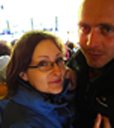

Cacaxtla:
Cacaxtla was the capital of the region occuped by Olmeca-Xicalanca settlements, probably a Mayan group coming from Central Mexico as early as 400AD. After the decline of Cholula (see previous post), Cacaxtla became the chief power of the South of Tlaxcala and the Valley of Puebla. By 1000AD, the city was abandoned. The site was only discovered in 1975.
- On the way to the ruins from the entrance, we could admire this nice view of the volcano Izta (see previous post) and its glacier,
- The "Gran Basamento" or the main platform was covered by a huge metallic roof to protect the paintings. Here were located the religious and civil buildings,
- Painting from the "Vestidos de Sacerdotes" or "priestly altar". This painting represents the bird man probably a ruler-priest of the Olmecas-Xicalancas. This bird man was associated with Quetzalcoalt, the generous deity who taught people art and agriculture. These paintings are unique as they combine the symbology of Altiplano cultures and Mayan influence,
- Part of the "Batallas por el Poder" or "battle for the power" wall. These paintings have been interpreted as confrontation between the local group and one from the South of Mexico. This painting could also represent a ritual in which the conquering warriors display their arms and the conquered warriors are sacrified. The painting is made from mineral and vegetal pigments,
- Detail from the Battle Mural. The wall was protected by a glass or plexiglass so the colours are faded.
San Miguel del Milagro:
San Miguel del Milagro is a small village close to the Cacaxtla archeological site. Why this name? Well probably a relation with San Miguel Archangel? Right!
The story is that San Miguel appeared in 1631 to one of the first baptised local men and told the man the location of a water fountain which will cure all the illnesses. But sceptical, the man kept for him the apparition and 2 weeks later, he became gravely ill. San Miguel appeared again and brought the man to the fountain telling him that he had to make the fountain known or he will be badly punished. So the family of the man, which was the only persons to believe him, started digging following the advice of an supernatural light to give the exact location and the help of a young man of an extraordinary appearance to remove the heaviest stones. And appeared the fountain but the local man, by the fear of people, kept the secret for him. Six months later, he started to feel lots of pain. San Miguel appeared again accusing the man of not complying with his desire regarding the fountain. So the man went to the fountain, filled two buckets of water and gave them to the priest who forwarded the water to the hospital. All the ill persons were cured after taking the water.
And so started the pilgrimage to this little village. The fountain, in front of the church, still exists but is often closed for lack of water.
- The decorated entrance of the church,
- On a side part of the church, the statue of San Miguel is visited by pilgrims who left all sorts of clothes and objects of sick relatives around the statue.







No comments:
Post a Comment